5 characteristics of elephant
Predator An animal that hunts and eats other animals for food. 5. Male elephants, or bulls, live alone once they become adults. Protostomes: Developmental Characteristics: 1. Characters are flat. This answer is helpful in a role where innovation and a focus on . Characteristics of Human Language. In some groups, some of these key chacteristics are present only during embryonic development. Encyclopædia Britannica, Inc. Nowadays, Scientists Classify living things into five mane groups called kingdoms. Mammals have a four-chambered heart. Domestic Goat's Physical Characteristics. 7 Sanctuaries Working to Save Abused and Neglected Wolves and Wolf-Hybrids. Multicellular: The animal kingdom excludes single-celled organisms such as a bacterium, amoeba, or Paramecium. Being publicly-funded gives us a greater chance to continue providing you with high quality content. Like African elephants, these groups occasionally join others to form larger herds, although these associations are relatively short-lived. Thinking About Adopting a Horse? Maximum plants are autotrophic in nature. Elephants are the largest living terrestrial animals. Found inside – Page 8... relationship to specific physical and behavioural characteristics in captive (and wild) African elephant bulls. ... correlates of musth and their temporal relationships in captive male African elephants is presented (chapter 5). As they contain chlorophyll, they are able to make photosynthesis and prepare their own food. The extra-large tub of popcorn at your local theater would need unlimited refills to satisfy an elephant like Raju here. With its large size, distinctive tooth structure . No other species has a structured language to communicate with. They can weigh up to eight tons. The body plan refers to the morphology of an animal, determined by developmental cues. Travelling to the threatened landscape of Kenya to witness struggling elephant families work out how to survive poaching and drought, then on to Yellowstone National Park to observe wolves sort out the aftermath of one pack's personal ... Presents a single resource for performing necropsies on a variety of taxa, including terrestrial and aquatic vertebrates and invertebrates Describes notable, unique gross and microscopic anatomical variations among species/taxa to assist in ... These animals are natureâs gardeners. 3. When street urchin Danny accidentally bids for Maharajah the elephant at an Edinburgh auction, his life is transformed as he is swept up on an unforgettable journey. A quick search on the internet gives us countless results on what the perfect guy is like. Non- linguistic symbols such as expressive gestures, signals of various kinds, traffic lights, road signs, flags, Braille alphabets, the symbols of mathematics and logic, etc.
Antony Stanley / Flickr (CC BY-SA 2.0)
, Photo courtesy of Amy Morrow, Thailand Elephant Sanctuary. But those are mere surface details; look a bit deeper and you'll . In general, Asian elephants are smaller than African elephants and have the highest body point on the head. Characteristics of plantae: 1. Usually very good or very bad with most characteristics exaggerated. The biggest elephant ever weighed 24,000 pounds and was 13 feet tall. They have backbones that house the spinal cords that run the length of their bodies. There are exceptions to many of these characteristics, however. They usually consume plants of almost any size, from grass to trees. Sorry Dumbo, that one's just a myth! Most amphibians reproduce in fresh water while a few lay their eggs on land and have developed mechanisms to keep the eggs moist. Go to first slide of the carousel. Symmetry 6. They’ll roam long distances for all kinds of reasons — in search of fresh food or water, looking for mates, getting to better climates during hot spells, and so on. Shape 4. Other highly interesting characteristics of the elephant are: Its trunk doesnât contain any bone, and is a very useful tool for elephants to collect food, make sounds, and identify smells. The (a) black bear is an omnivore, eating both plants and animals. There, they briefly breathe in oxygen while still being underwater. Found inside – Page 256Figure 5-21 Code for the h3 elements with the clear class applied






